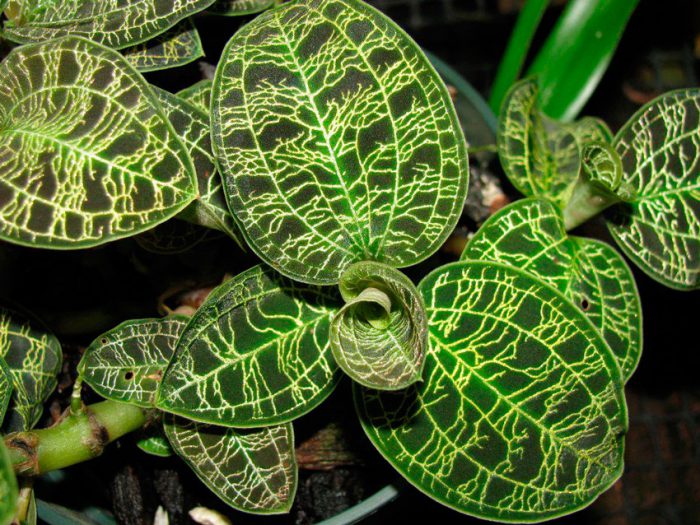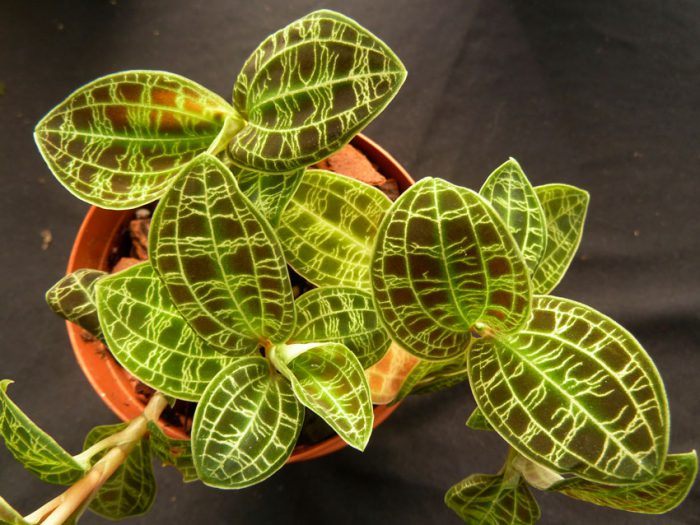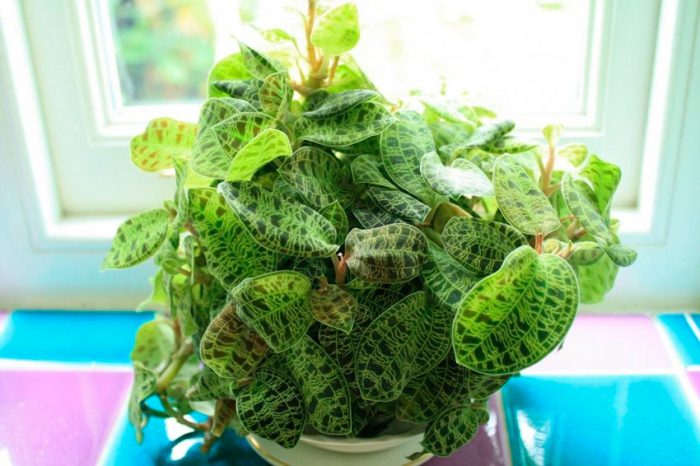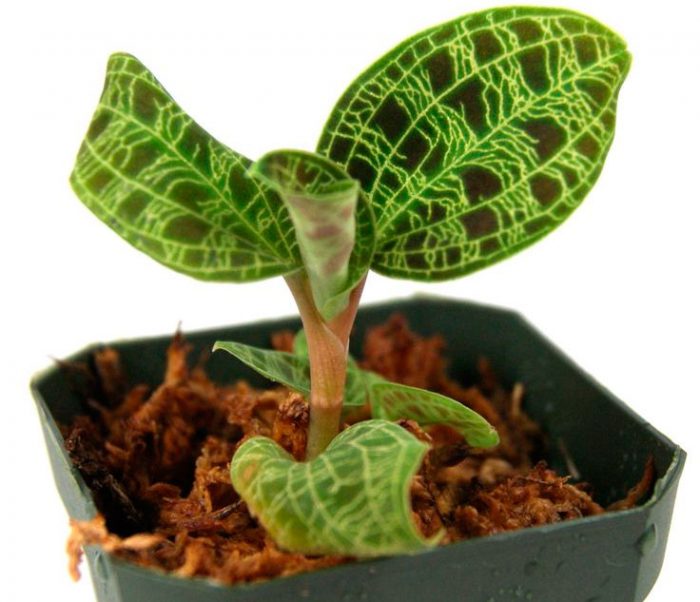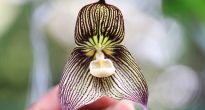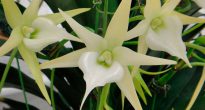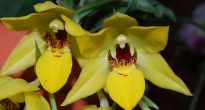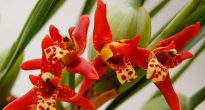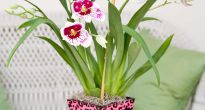A plant such as Macodes Petola is a very rare precious orchid (Jevel Orchids). They are found in very small numbers from South America to Asia. Such plants are prized for their lovely velvety leaves. Experts classify as precious orchids plants of various genera of the extensive orchid family from the subtribe Goodyerinae. So, these are Macodes, Ludisia, Dossinia, Anoectochilus, Goodyera, Zeuxcine and others.
The foliage of such orchids has incredible beauty. So, on the velvety surface, you can see fancifully arranged veins that can be painted in various colors. They seem to be made of small stones sparkling in the light. The more beautiful the leaf, the thinner its pattern, since in this case it shines very brightly and the shimmer is noticeable even with very little movement.
Such orchids differ among themselves by the color of the veins, the pattern, the intensity of their location, as well as the color of the leaf plate itself (for example: pale green, almost black, silver, pale cherry and others). Often the drawing on the leaves depends on the conditions in which the plant is located, as well as on its age. The racemose inflorescences consist of relatively small flowers, which are often white in color. There are species whose flowers smell very nice. In natural conditions, precious orchids easily and simply interbreed with each other, in this regard, sometimes there are certain difficulties in determining the exact species.
Content
Plant features
Makodes petola is represented by epiphytic, as well as terrestrial plants, which are directly related to the numerous orchid family. Their growth patterns are sympodial. This plant belongs to the group of "precious orchids" ("Jevel Orchids") and is prized for its very spectacular foliage. The name makodes comes from the Greek language, so “macos” means “extension, length”, which is associated with the lip, which has an elongated shape.
A genus such as makodes unites about 7 species that can be found in the tropical rainforests of Oceania, as well as Southeast Asia. The most popular of the types is makodes petola. Such a precious orchid has truly beautiful leaves. One might get the impression that the pattern on the leaves is embroidered with gold threads, and they shine and shimmer in the sunlight.Thanks to such rare and very spectacular leaves, this plant is considered a kind of jewel.
Under natural conditions, such a "precious orchid" grows on the islands of Java, from the Philippines to Sumatra, New Guinea, Malaysia. Prefers to grow in tropical forests (in shady mountain forests), where there is high humidity. Makodes petola grows on fallen tree trunks, as well as on rocks covered with humus and moss.
Such a miniature orchid has creeping shoots, which, moreover, branch strongly and reach a height of only 7 to 8 centimeters. The velvety leaf plates can be painted in various shades from greenish gray to emerald. On their surface are golden veins that shimmer in the light. The flowers of the plant are inconspicuous and very small. After the end of flowering, the rosette dies off, and at the same time children (lateral processes) are formed. These plants are grown in collections, as well as in winter gardens.
Caring for the Makodes petola orchid at home
Lighting and location selection
Under natural conditions, this plant prefers to grow in dark places with high humidity. When growing it in indoor conditions, conditions similar to natural conditions should be provided. So, makodes petola requires not very bright lighting, high air humidity, which should be at the level of 80-90 percent, heat and a substrate that is always in a humid state. For its cultivation, it is recommended to use a special greenhouse or florarium.
How to water
Water should not stagnate either in the substrate or in the pan, as this can lead to the formation of rot on the root system, as well as on the lower part of the shoot. It is necessary to water systematically. Watering is carried out as the soil dries up. Filtered or soft water is suitable for this.
Temperature regime
In summer, the plant grows well and develops at temperatures from 18 to 30 degrees, in winter - you need to make sure that it is not less than 18 degrees. A difference in daily temperatures is recommended, while the difference between day and night temperatures should be about 4 degrees. In the warm season, it is recommended to transfer this orchid to the street (to the balcony, to the garden). In this case, the plant must be protected from direct sunlight, precipitation and gusts of wind.
Earth mix
To prepare the soil mixture with your own hands, you need to combine the fine-grained bark of coniferous trees, rotted leaf earth, coarse sand, foam plastic, sphagnum, charcoal, expanded clay, as well as broken shards. Do not forget to make a not very thick drainage layer at the bottom of the container. After planting the plant, a not very thick layer of moss should be laid on top of the soil mixture. Experts advise to transplant in March – April. Such an orchid needs a cramped pot, the diameter of which does not exceed 6 centimeters.
Fertilizer
Top dressing is carried out carefully, as the delicate roots can burn out. From spring to autumn, they are fed once every 3 weeks, and after that - once every 5 weeks. To prepare a nutrient solution, 3 or 4 drops of fertilizer are poured into 2 liters of water. A high concentration of the solution has a detrimental effect on the root system. For feeding, it is recommended to use a specialized fertilizer for orchids, as fertilizers for other indoor plants contain completely different nutrients.
Breeding method
When grown indoors, this plant can be propagated by cuttings or by dividing an overgrown specimen. When dividing, you need to make sure that there are at least 3 sprouts on each division. This plant has a branched, creeping stem. In the event that roots appear next to the adult leaves, it will be possible to carry out the grafting procedure. A part of the shoot is cut onto the cutting, while it must have 2 or 3 stem nodes and roots on it.Places of cuts should be treated with crushed charcoal or activated carbon. Then the cutting is dried and planted in the prepared soil mixture. Also, for rooting, a glass of water is sometimes used, to which chopped charcoal should be added. Leafless stem cuttings are also used for reproduction. They should be placed horizontally on moistened sphagnum, while the cutting should not be buried.

